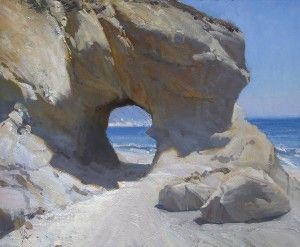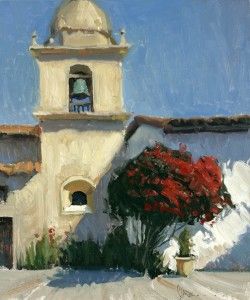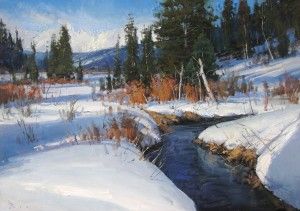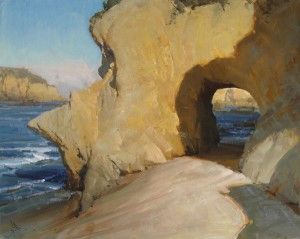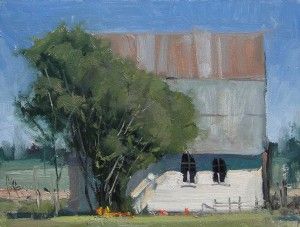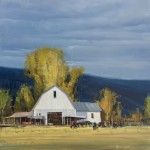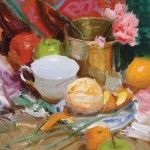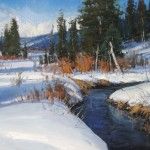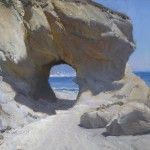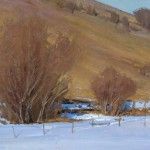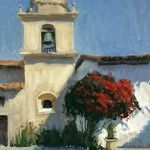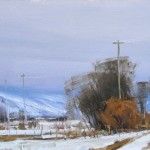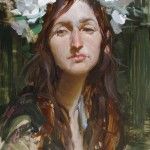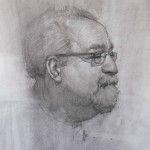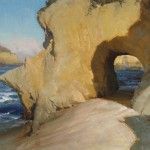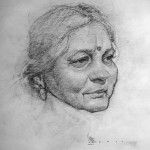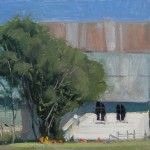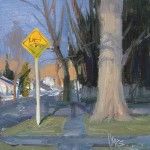Utah artist Josh Clare puts appreciation and joy in the paint
By Gussie Fauntleroy
This story was featured in the February 2014 issue of Southwest Art magazine. Get the Southwest Art February 2014 print issue or digital download now–then subscribe to Southwest Art and never miss another story!
Painter Josh Clare likes to say, “When I grow up…” As in: “When I grow up, I’ll do huge, multifigure, Russianesque pieces, large-scale landscapes with figures!” There’s a playful note in his voice as he says this, knowing he’s borrowing a kid phrase that gives him permission to remain wide open to wonder and enthusiasm, and especially to the joy of communicating the depth of beauty he sees when he really looks. At the same time—especially since marrying during his sophomore year in college and considering the responsibilities of a family—his enthusiasm is infused with earnestness and sincerity in the goals he sets for himself with his art.
“When I grow up” also reflects the Utah-based painter’s awareness of his much-to-learn position along the spectrum of artistic growth. At 31, he speaks of beginning to discover a distinctive style of translating visual beauty—and, he believes, spiritual truth—into a language of paint. Collectors and art lovers, it seems, may be ahead of him on this point. Clare earned his first gallery representation just weeks after graduating from Brigham Young University in Idaho in 2007. Since then he has gained a growing collector following and won a number of awards, including first and second place, artists’ choice, and best of show, at plein-air invitational and juried exhibitions around the West.
In Clare’s small, tidy studio at the back of his 100-year-old brick Victorian house in Paradise, UT, are two walls covered with copies he has done of favorite paintings by other artists. The carefully executed works are a reminder of his intense commitment to continually refining his understanding of paint by discovering how others have handled it. But the copied paintings also serve as a powerful confidence builder when Clare becomes frustrated with a canvas he’s working on. “It’s easy to copy because the artist has already solved the problems,” he explains. “So I copy a painting and remember the feeling of ‘Yeah, I can do this!’”
Gazing out the studio window, Clare takes in the cottonwoods, pines, and oaks on his small river-bottom acreage. Beyond are fields, with mountains rising in the distance. He and his wife, Cambree, bought the property last summer, returning to the land of his heart after a few years in a Phoenix-area subdivision, where he desperately missed the changing seasons and open spaces. The view takes him back to his boyhood south of Provo, where he grew up as the eldest of eight children. At that time, galleries, art museums, and original paintings were not part of his world. But what he sees as God’s artwork—the extraordinary beauty of the natural world—was always there.
Clare’s creative journey began to take form when he was 5 or 6 years old, on his first visit to a bookmobile. Irresistibly drawn to pictures, he pulled out a book of Calvin and Hobbes comic strips. “I was mesmerized. I fell in love with the drawings and spent hours staring at them. Then I started to check out art books,” he recalls. His school’s art classes were mediocre and uninspiring, but he continued to draw, determined to become very good at it. During high school he interned with a locally based freelance animator and vaguely imagined a career in animation. The rapid rise of digital animation, in which he had no interest, soon ruled that out. But it left him open to discovering his passion for painting a few years later at BYU.
After a two-year church mission on Japan’s northern island of Hokkaido, where the clean, minimalist aesthetic of temples and immaculately tended gardens perfectly matched his visual sensibilities, Clare entered the illustration program at BYU in Rexburg, ID. As it happened, some of the country’s best illustrators were teaching there at the time, including department head Leon Parson. “I’m still blown away by the instruction I received at BYU-Idaho,” he says. “I went to that school just because it felt right, and it turned out to be one of the only colleges around that was still teaching students how to draw and paint what they see. I’m extremely blessed.”
In Rexburg, Clare lived not far from acclaimed landscape painter Scott Christensen, who gave the young artist sage advice, echoed later by western painter Bill Anton: Get outside and paint from life. As part of his introductory college painting class at age 24, Clare visited Jackson Hole, WY. His first-ever gallery experience left him astonished at the mastery he saw in paintings by Mian Situ, Morgan Weistling, and others, and even more stunned when he noticed the prices. Suddenly he realized it was possible to make a living with art. “Thanks to the summer internship doing graphic design, I knew I had to be in creative control, not executing someone else’s ideas, or I was going to have a nervous breakdown. It was a good thing to realize early,” he says, smiling. “With painting I make all the decisions, and whether I fail or succeed is all on my own shoulders. I wouldn’t have it any other way.”
Clare knew that if he wanted to set out as an artist after graduation, he had two years to paint and paint, compressing as much experience and learning as possible into that time. And he did. He constantly sketched and painted from life, taking to heart the words of artists he greatly respects. He also studied the work of painters from the past, in particular Nicolai Fechin and John Singer Sargent. After earning a degree in illustration, he took down his BFA-show paintings from the university gallery wall, loaded them up, and drove to Jackson Hole. At Astoria Fine Art, the gallery director was impressed, and Clare had the feeling the gallery was a good match for his work. But the space was already full, with no room to hang another piece. “I said, ‘You can put one of my paintings on the floor—I want to be here,’” he recalls. So a painting was displayed on the gallery desk. Within weeks it had sold.
Since then Clare has seen his approach to painting, and his technical skills, continuously evolve. Among recent works that most excite him is the painting THE OTHER SIDE (see page 68), so titled because he previously painted the Laguna Beach, CA, keyhole rock from the opposite direction. “I’m discovering a way of painting that feels like my own,” he reflects. “The longer I do this, the more enamored I am with the subtle, interesting variety you can achieve with oil paint. With nearly every painting I adore, it’s not about the subject, but about how the artist handled it.” He finds himself spending more time these days on each painting, letting parts of it dry and coming back in with glazes and other techniques that cannot be applied wet on wet. His goal, inspired by the work of Fechin and others, is lively diversity in paint-application methods within a single piece, yet with a unified feeling in the painting as a whole.
Limitless possibilities are opened by this approach, and Clare recently decided to follow the suggestion of an artist friend who advocates coming back to “old junkers”—paintings the artist considers failures—and playing around with them. A painting featuring a yellow-brown Montana hillside sloping down to meet a snowy pasture was one such piece. “I did that painting, put it in the garage, and thought it was a failure. It sat there for two or three months. I pulled it out one day, spent a couple of minutes on it, glazing and scumbling (applying a thin layer of paint to produce a softening effect), and thought—holy cow, I love that!” he remembers. “I’m constantly amazed at how thin the line between not-quite-there and right-on is. The tiniest stroke can mean everything. It’s a very delicate balance, but when it happens, you know it.”
Clare’s enthusiasm for painting is matched by equal delight when he talks about his other passions, among them: winter sports (especially snowboarding), volleyball, guitar, and song writing. And of course, Cambree and their children—4-month-old Anna and 5-year-old Nathan, whom their father calls “ridiculously cute.” The artist also has been spending time lately teaching himself to build frames. Another “very meaningful” recent project, with two fellow painters, is a series of landscapes along the Mormon pioneer trail. The trio hopes to exhibit the works together in the near future. “I’m type A, driven,” Clare admits. “I have to be painting, so to balance that I remind myself that I came to the earth to become a good person, a good dad, and a good husband.”
Always remembering that his ultimate artistic motivation is to express the magnificence of creation as fully as possible, Clare believes this intention “gets into the paint. I don’t know how on earth that happens. But if I’m trying to create and to please God and bless people—if I have pure motives like that and I feel the beauty and awe and majesty of God’s creation, that gets into the painting and stays there. If it gets in, you never erase it.”
representation
A. Banks Gallery, Bozeman, MT; Astoria Fine Art, Jackson, WY; Greenhouse Gallery, San Antonio, TX; www.joshclare.com.
Featured in the February 2014 issue of Southwest Art magazine–click below to purchase:
Southwest Art February 2014 print issue or digital download Or subscribe to Southwest Art and never miss a story!
- Josh Clare, White, oil, 48 x 48.
- Josh Clare, Peeled, oil, 11 x 14.
- Josh Clare, Teton Pass, oil, 30 x 40.
- Josh Clare, The Other Side, oil, 18 x 18.
- Josh Clare, Ochre, oil, 18 x 33.
- Josh Clare, Carmel Mission, oil, 11 x 14.
- Josh Clare, December Harmony, oil, 12 x 20.
- Josh Clare, Flowers, oil, 12 x 16.
- Josh Clare, Fred, charcoal, 16 x 20.
- Josh Clare, Keyhole Rock, oil, 24 x 30.
- Josh Clare, Naomi, charcoal, 18 x 24.
- Josh Clare, Shed, oil, 9 x 12.
- Josh Clare, The Sign, oil, 6 x 6.
MORE RESOURCES FOR ART COLLECTORS & ENTHUSIASTS
• Subscribe to Southwest Art magazine
• Learn how to paint & how to draw with downloads, books, videos & more from North Light Shop
• Sign up for your Southwest Art email newsletter & download a FREE ebook






